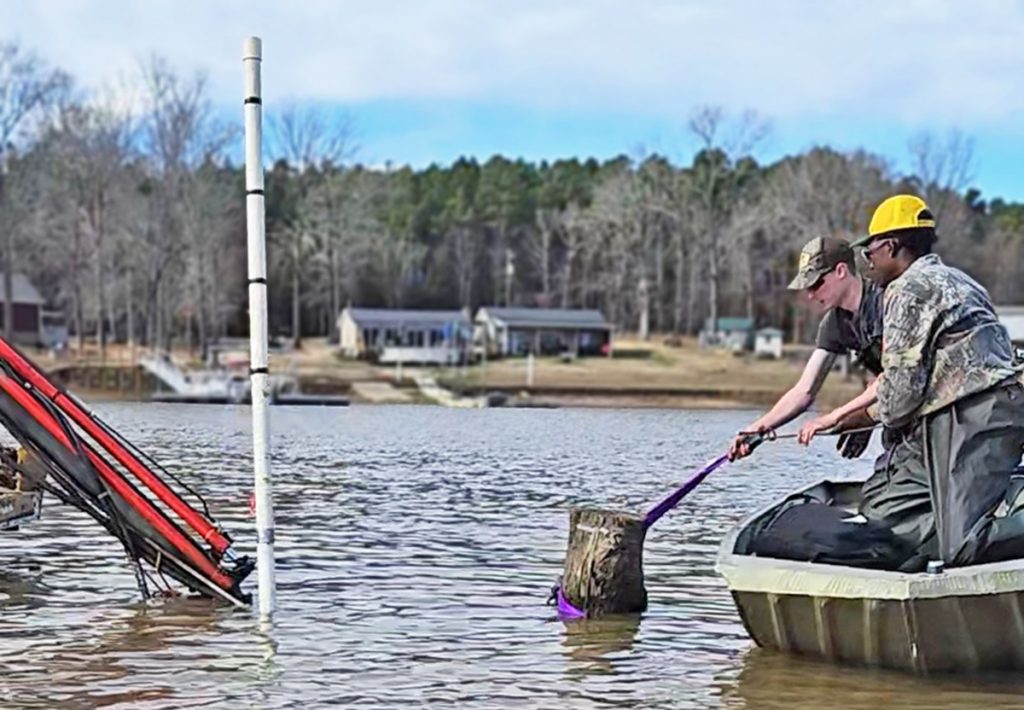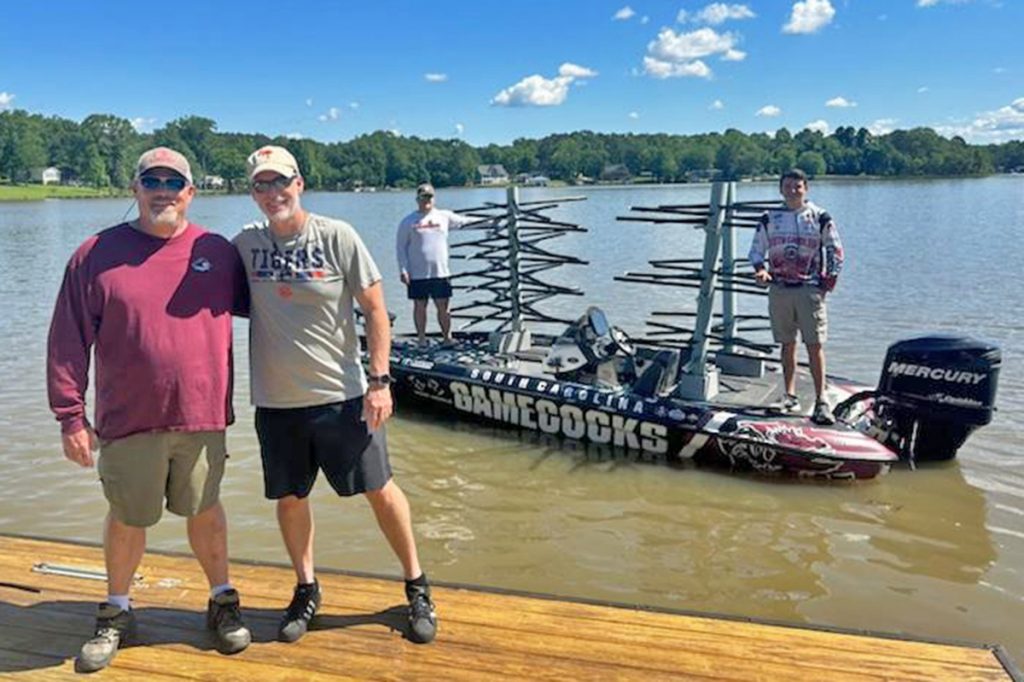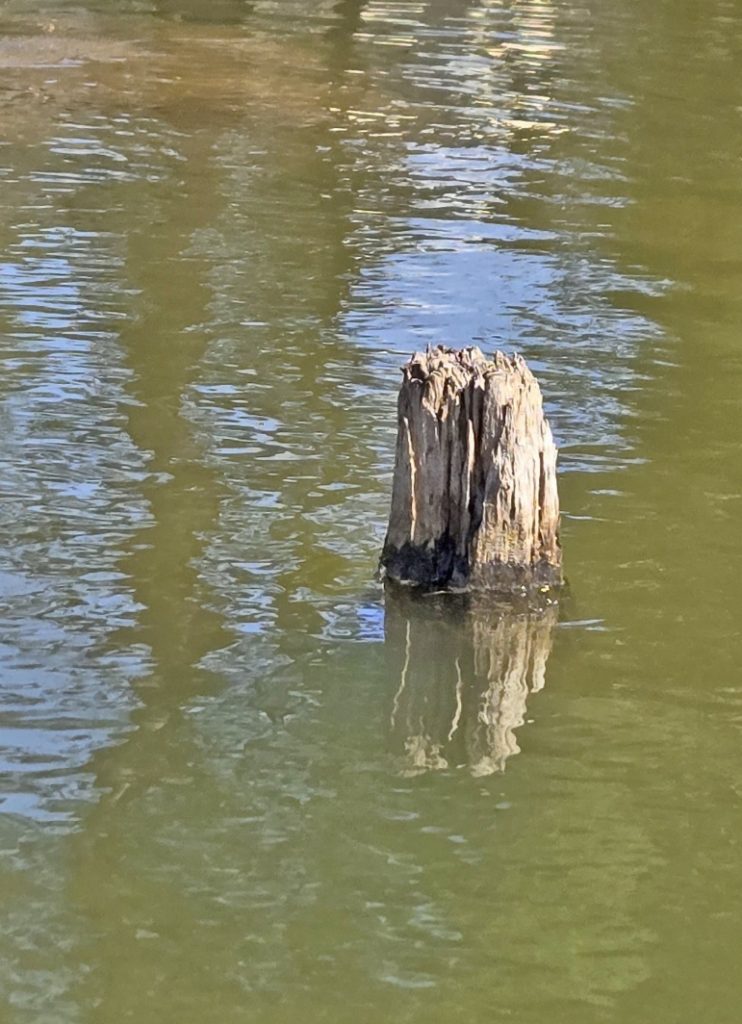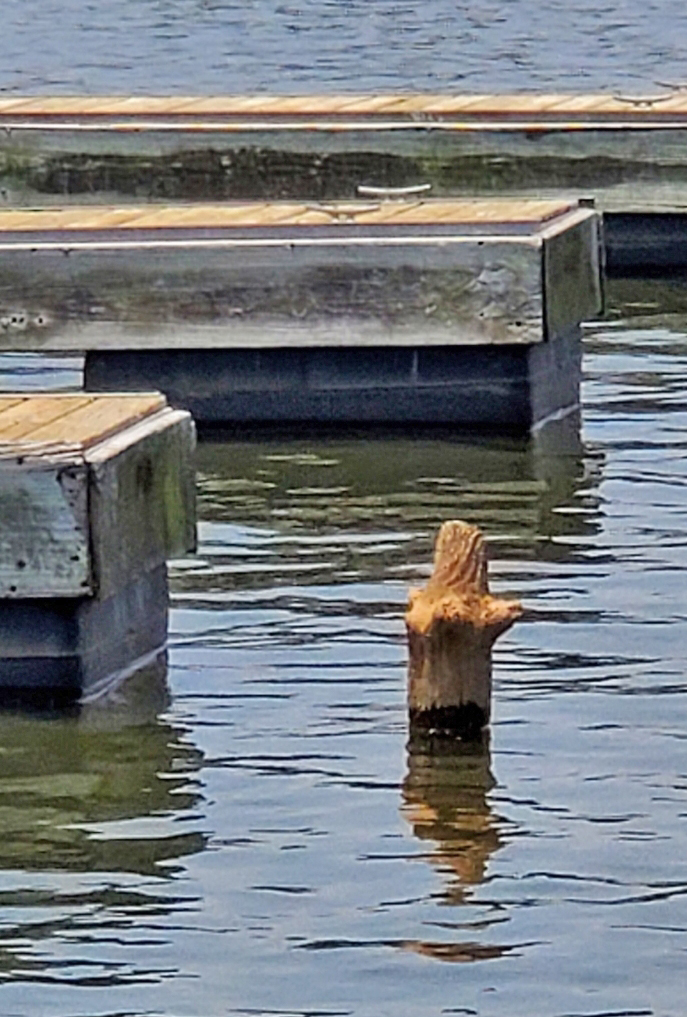
LAKE WATEREE – The long-dead trees that sat dangerously just below the surface of Lake Wateree have been cut down to a safer level, says Rod Wilkes, the Lake Wateree homeowner who persisted though months of bureaucracy to get the project done.
Wilkes, who’s since joined the board of the Lake Wateree Association, says roughly 600 trees were left standing when the lake was created more than a century ago – a decision that, decades later, made the lake a minefield of hazards for unsuspecting boaters.
“I was sitting in my hammock one Sunday and watching the boats hit them,” Wilkes says. “They’d just be driving through there and just hit it [one of the stumps], and I was like, ‘These people have no idea that’s there.’”
Wondering about potential solutions, he looked for a means to remove them – and found a guy with a stump boat who could cut them shorter.
When he heard about a dam maintenance project that would lower the lake level during many months of construction, he says, he saw an opportunity to tackle the stump problem.
To longtime lake residents, he says, the stumps were a known hazard – and they knew how to navigate around them based on passed-down knowledge of what the land looked like before 1920, when the lake was completed.
“I always knew they were there. When I was a child, part of some of them were still coming out of the water,” he says.
“And how you avoided them was not the logical thing. Like, you had to stay on the original creek bed, which was over next to one of the banks, which it’s not logical for a boater to say, ‘I need to be close to this bank over here to not hit anything.’ You’d say, ‘I’ve gotta go right down the middle; that would be the safest place.’ Well, right down the middle was the worst.”
For boaters who were unaware of the stumps and their location, collisions were common.
Back when the lake was created as part of a hydroelectric power project in the early 20th century, Wilkes says, this sort of problem was not anticipated.
“They built the lake over 100 years ago. They built the lake when there were no gas-powered vehicles,” he says, noting that, in that era, even logging was done using horses.
He says there were several reasons why the trees were not cut before the area was flooded by the man-made lake. Features of the land, such as swamps, may have made it difficult. There was also a land dispute that was going on at the time – and perhaps even a belief by some that the lake would be temporary.
But, whatever the reason, the lake was created with the trees left in place.
“At that time, there were no boats. The only boats were something you would paddle. There was no concept of a recreational lake,” Wilkes says. “And they thought, ‘Oh, it will never matter.’”
As it turned out, generations later – with a century of lifestyle and technology changes that turned places like Lake Wateree into recreational destinations – it did matter. But the problem developed slowly over many years.
“So, there were these trees there, and my dad, when he was a child, he remembers them coming up out of the water,” Wilkes says.
“And then, over time, the trees rotted. Anything that was in the air rotted, and anything that was underwater just kind of hardened or petrified. So, at summer lake levels, they were about a foot and a half to two feet below the surface, and you really had to know how to navigate; you couldn’t see them.”
Pictures taken after the lake level was lowered for the recent dam project revealed some pretty horrifying underwater hazards: Not just 30-inch-wide stumps that posed a collision hazard for boats, but also thin, chillingly spear-sharp tree remains, a potentially deadly hazard to children jumping off of boats into the water to swim.
“If somebody would’ve jumped and landed on that, it would’ve been awful,” Wilkes says, “and how it did not happen, I don’t really know.”
In addition to the obvious safety issue, he says, the stumps also created a financial issue for boat owners, many of whom suffered thousands of dollars in boat damage after collisions, and also an environmental issue, as oil and other pollutants can be released into the lake when a collision occurs.
So, when he heard that the lake would be lowered from its usual 97 feet down to 94 feet to accommodate the dam improvement project, Wilkes reached out to Duke Energy, the power company that manages the lake, for permission to cut the stumps.
He says he was told that the company’s approval would depend on review by the relevant government agencies: the U.S. Fish and Wildlife Service, the U.S. Army Corps of Engineers, the South Carolina Department of Health and Environmental Control, and the South Carolina Department of Natural Resources.
One of the agencies took issue with the proposal, he says, and that was SCDNR, citing concerns about the possibility of impacting fish habitat. So, Wilkes says, he brought the issue to a meeting of the legislature-approved board that oversees the agency.
Ultimately, the board saw the common sense of the proposal, he says, and gave approval for the project to proceed.
Duke Energy then gave its permission, but with some requirements that came out of the process: All material cut from the stumps had to be removed from the lake, and some fish habitat had to be installed.
When it came time to do the work, Wilkes says, the woman who manages the lake level for the power company was very helpful, further lowering the water level to 93.5 feet to help facilitate the project.
“I’m 55 now, and I’ve been out here my whole life, and when she dropped it to 93.5, stumps appeared that we did not know were there,” he says. “So, that gave me a lot of comfort that once the lake gets back to the normal operating level, we’re going to be in really good shape.”
He says the need to remove the heavy stumps added difficulty to the project – but it took him less than a week to raise the $60,000 from homeowners to get it done.
The stumps were cut in February, he says, down to a height equal to a 90-foot water level on the lake. This means that the stumps now only stick up 10 feet from the lake bottom – four feet shorter than they were before.
He says the final phase of the project – the installation of some artificial fish habitat – took place on May 11 with help from the University of South Carolina’s bass fishing team.
“The bass fishing team came out and determined the best place for the habitat, put it in the water, and marked it with GPS so we can share it with fisherman. There are now two sites of fish habitat in the area,” he says. “I think the fisherman are going to be excited to have this in.”
With the stumps lowered, Wilkes says, they’ll now be 7 feet below the surface when the lake is returned to its average 97-foot level – deep enough to no longer be a hazard to boats even during the summer months, when the water level is a bit lower.
Now, he says, he can turn his attention to some other issues impacting Lake Wateree – like what to do about runoff into the lake that’s promoting the growth of toxic algae. He says he’s glad that, after months of effort, he can finally say that the longstanding stump hazard has been mitigated.
“It’s safer. And now people are going to be able to come out there and when the water level is where it should be in the summer, they’re not likely going to hit anything,” he says.
“It’s still always dangerous – there’s always risk, and that’s still why you should never jump headfirst into a lake – but certainly where we are is a lot better off than where we were…. We’ve not eliminated the risk completely, but we’ve made it much safer.”















